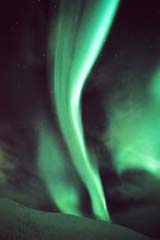Unveiling the aurora

The Northern Lights: powered by an immense electrical circuit. <br>© Corbis <br>
Satellites have detected the shifting forces that weave the Northern Lights.
A group of four spacecraft has given scientists their first glimpse of the immense electrical circuit above the Earth that creates the shimmering veil of the aurora borealis, or Northern Lights1.
In January 2001 the four satellites of the European Space Agency’s Cluster mission encountered a beam of electrons moving away from the Earth near the North Pole. The beam was on the outward-bound leg of its journey from the Sun, through the Earth’s atmosphere – where it creates the aurora – and back into space.
Passing through the beam in close succession, the satellites recorded it growing and vanishing over 200 seconds, Goran Marklund of the Royal Institute of Technology in Stockholm, Sweden, and co-workers report. Such fluctuations leave their mark in the shifting curtains of the spectacular display over the North Pole.
Auroral displays happen when the solar wind – the stream of electrically charged particles ejected from the Sun – penetrates the ionosphere, the region of the Earth’s upper atmosphere between 80 and 200 km above the ground. The edge of the planet’s magnetic field deflects most of the solar wind. But the field lines channel some particles down towards the poles.
The particles collide with molecules in the atmosphere above the North Pole, producing the glow of the aurora borealis.
The particles streaming down from the Sun are mostly negatively charged electrons. The funnel-shaped electric field at the North Pole focuses these electrons into a kind of beam. This beam generates the aurora when it enters the ionosphere, which is rich in charged particles.
Beam up
But the electrons must keep moving. The beam gets bent sideways in the auroral region so that it runs parallel to the Earth’s surface, before turning upward and streaming back into space.
It has long been thought that another, positively charged electric field draws the electrons up from the ionosphere and fires them back into space. According to this idea, the aurora is a consequence of this vast electrical circuit, in which electrons flow from a negative to a positive terminal, like those of a battery.
The aurora owes its ever-changing beauty to the inconstancy of the circuit. Solar winds ’beat’ the magnetic fields, causing them to flicker on and off.
Cluster consists of four satellites launched in 2000 – Rumba, Salsa, Samba and Tango – that orbit between 19,000 and 119,000 kilometres above the Earth, passing in and out of the planet’s magnetic field.
Previous spacecraft have detected the upward flow of electrons. But it hasn’t been possible to follow how the beam changes over time. The Cluster mission can study this because the four satellites, orbiting in formation, pass through the same region of the magnetic field at different times.
The upward beam of electrons creates a kind of ’anti-aurora’ or black aurora, sometimes visible from the ground as black patches or rings in the Northern Lights.
References
- Marklund, G. T. et al. Temporal evolution of the electric field accelerating the electrons away from the auroral ionosphere. Nature, 414, 724 – 727, (2001).
Media Contact
All latest news from the category: Physics and Astronomy
This area deals with the fundamental laws and building blocks of nature and how they interact, the properties and the behavior of matter, and research into space and time and their structures.
innovations-report provides in-depth reports and articles on subjects such as astrophysics, laser technologies, nuclear, quantum, particle and solid-state physics, nanotechnologies, planetary research and findings (Mars, Venus) and developments related to the Hubble Telescope.
Newest articles

Silicon Carbide Innovation Alliance to drive industrial-scale semiconductor work
Known for its ability to withstand extreme environments and high voltages, silicon carbide (SiC) is a semiconducting material made up of silicon and carbon atoms arranged into crystals that is…

New SPECT/CT technique shows impressive biomarker identification
…offers increased access for prostate cancer patients. A novel SPECT/CT acquisition method can accurately detect radiopharmaceutical biodistribution in a convenient manner for prostate cancer patients, opening the door for more…

How 3D printers can give robots a soft touch
Soft skin coverings and touch sensors have emerged as a promising feature for robots that are both safer and more intuitive for human interaction, but they are expensive and difficult…





















